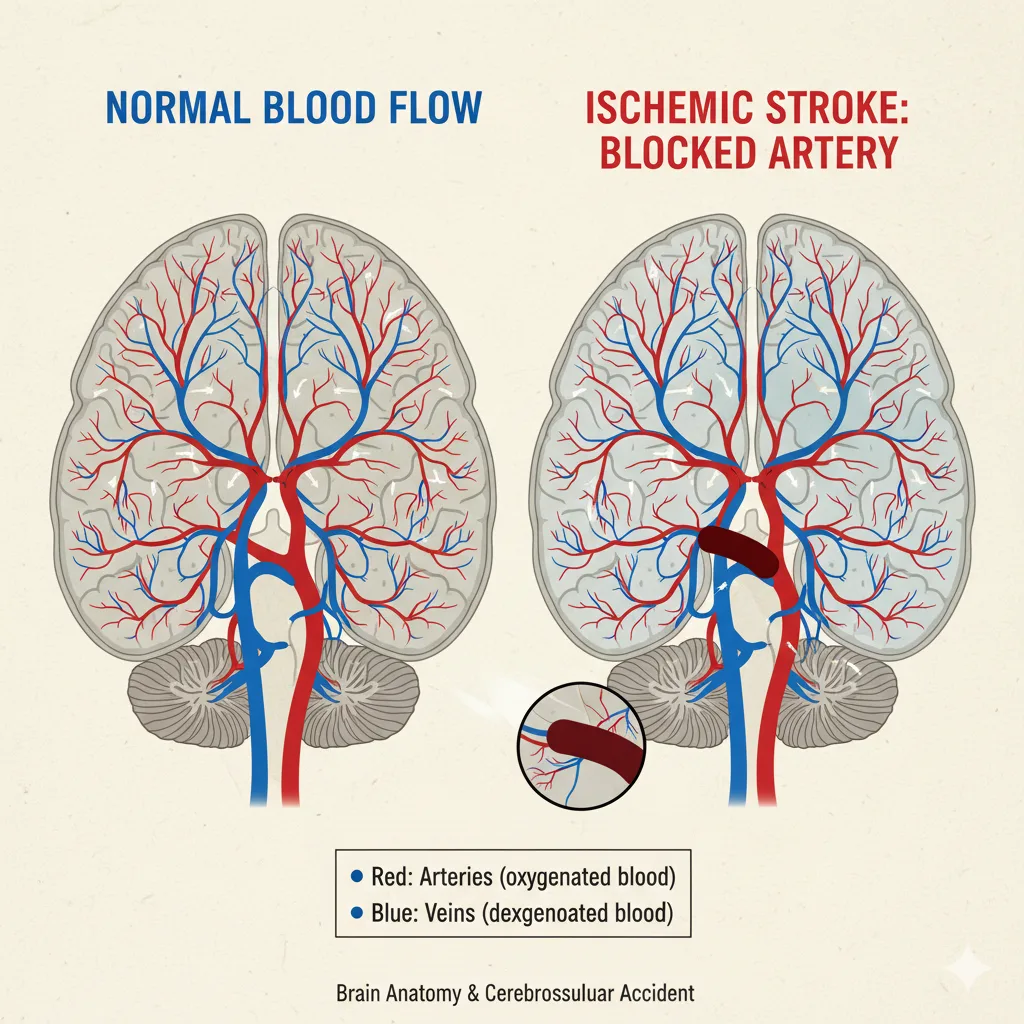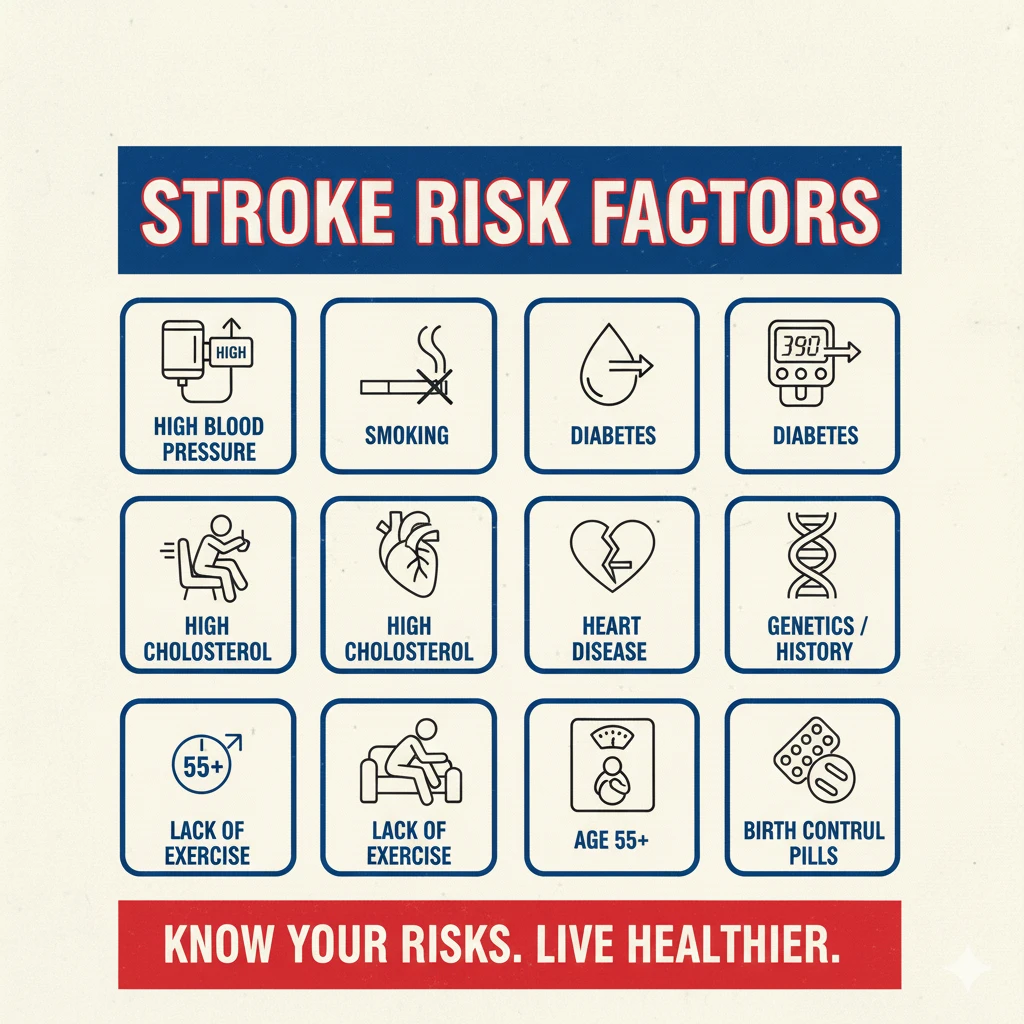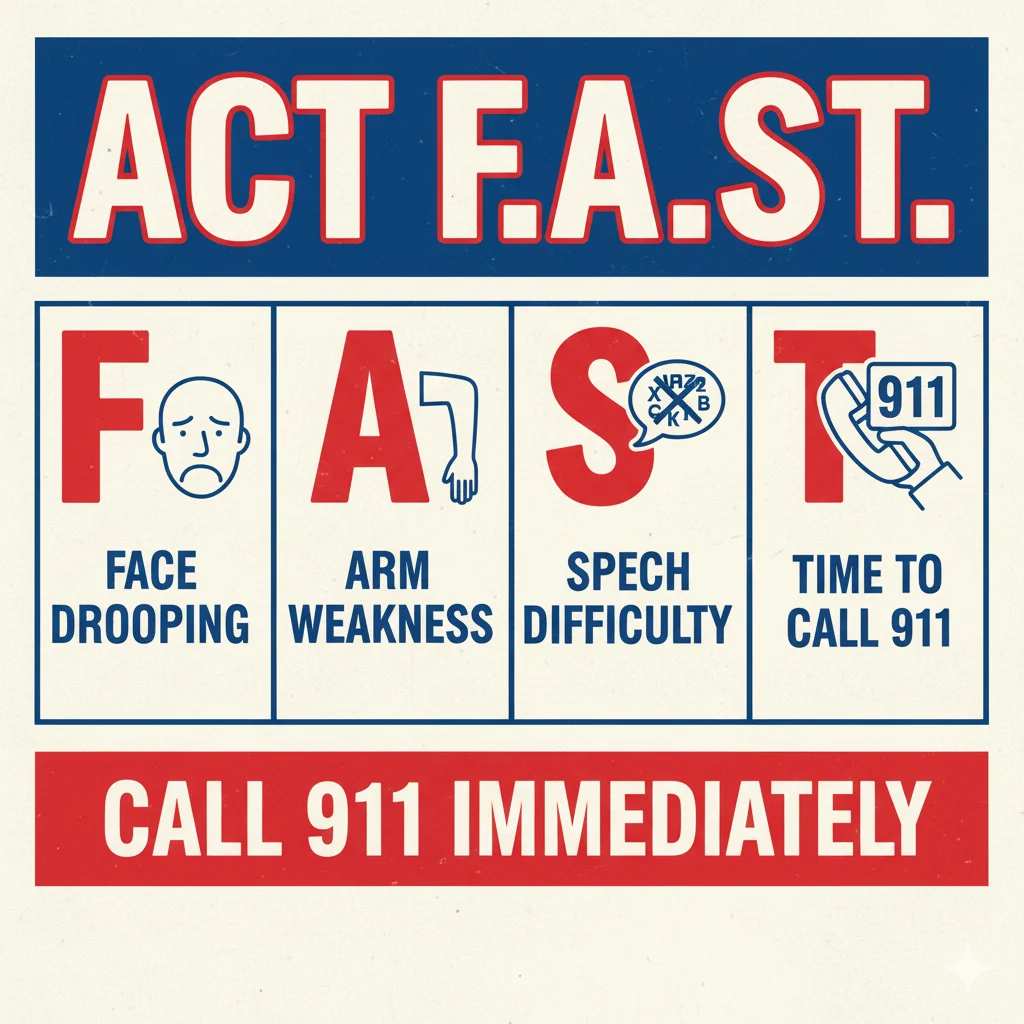Strokes often seem to strike without warning, leaving victims and their families in shock and despair. But the truth is far more hopeful: in many cases, your body begins sending distress signals weeks or even a month before a major stroke occurs. These early warning signs are your body’s way of crying out for help — subtle symptoms that many people dismiss as stress, fatigue, or just “getting older”.
Recognizing these pre-stroke symptoms could mean the difference between life and death, between full recovery and permanent disability. Studies show that warning signs of an ischemic stroke may be evident as early as seven days before an attack, and in some cases, symptoms can appear even earlier. The problem? Most people ignore persistent headaches, occasional dizziness, or brief episodes of confusion, not realizing their brain is struggling with reduced blood flow.
Here are the most common warning signs your body may give you up to a month before a stroke — and what you can do to protect yourself.
What Exactly Is a Stroke?
A stroke is a medical emergency that occurs when blood flow to part of the brain is interrupted or severely reduced, depriving brain tissue of oxygen and essential nutrients. Within minutes, brain cells begin to die, which is why stroke is often called a “brain attack”.
There are two main types of stroke:
Ischemic Stroke: This is the most common type, accounting for about 80% of all strokes. It occurs when a blood clot or plaque buildup blocks or narrows an artery leading to the brain, cutting off the blood supply.
Hemorrhagic Stroke: This type happens when a blood vessel in the brain ruptures or leaks, causing bleeding in or around the brain tissue. Though less common, hemorrhagic strokes are often more deadly.
Both types can result in permanent brain damage, long-term disability, or death if not treated immediately. The key to survival and recovery lies in recognizing the warning signs early and seeking medical attention before irreversible damage occurs.

One Month Before Stroke — Early Warning Signs Your Body Sends
Your body is remarkably intelligent. When blood flow to the brain becomes compromised, it begins sending alarm signals that something is seriously wrong. Here are the most important warning signs that may appear weeks to a month before a stroke:
1. Persistent Dizziness or Loss of Balance
If you’ve been feeling lightheaded, off-balance, or frequently dizzy without an obvious cause, your brain may not be receiving adequate blood flow. This happens when arteries begin narrowing or partially blocking, reducing oxygen delivery to the parts of your brain that control balance and coordination.
You might find yourself stumbling, bumping into objects, or feeling unsteady when walking. Some people describe it as vertigo or feeling like the room is spinning.
➡️ What to do: Don’t dismiss frequent dizziness as just an inner ear issue. Schedule a check-up with your doctor immediately and have your blood pressure monitored.
2. Unexplained Fatigue or Weakness
Feeling extremely tired despite getting adequate rest is a common pre-stroke symptom that’s often overlooked. This isn’t normal tiredness — it’s profound exhaustion that makes even basic tasks feel overwhelming.
Your body is working overtime to compensate for reduced blood flow to the brain, leaving you drained of energy and motivation. Women, in particular, often experience unusual fatigue before a stroke.
➡️ What to do: If persistent fatigue is accompanied by other symptoms on this list, seek medical attention immediately.
3. Numbness or Tingling on One Side of the Body
Intermittent numbness, tingling, or weakness — especially on one side of your face or body — is a serious red flag. This symptom may come and go, appearing for a few minutes or hours before disappearing completely.
This indicates that certain areas of your brain aren’t receiving enough oxygen due to compromised blood flow. Even if the sensation resolves quickly, it could be a mini-stroke (TIA) and requires immediate medical evaluation.
➡️ What to do: Never ignore one-sided numbness or weakness, even if it goes away. Call your doctor or go to the emergency room immediately.
4. Sudden Vision Problems
Vision changes are among the most alarming pre-stroke symptoms. You might experience blurred vision, double vision, or sudden vision loss in one or both eyes.
Some people report difficulty focusing on objects or seeing “spots” in their field of vision. These symptoms occur when blood flow to the visual cortex — the part of your brain that processes visual information — becomes restricted.
➡️ What to do: Sudden or progressive vision changes warrant an immediate eye exam and neurological evaluation.
5. Frequent Headaches or Severe Head Pain
Unexplained, recurring headaches — especially if they’re more intense than usual or have a different character than your typical headaches — can signal an impending stroke.
A severe, excruciating headache with no apparent cause is particularly concerning and may indicate a hemorrhagic stroke or a warning that one is imminent. These headaches often don’t respond well to over-the-counter pain medications.
➡️ What to do: If you experience a sudden, severe headache unlike any you’ve had before, call 911 immediately.
6. Slurred Speech or Difficulty Understanding Words
Speech difficulties are classic stroke warning signs that shouldn’t be ignored. You might notice trouble forming complete sentences, slurred or slowed speech, or difficulty finding the right words (a condition called aphasia).
Some people also struggle to understand what others are saying to them, even though they appear alert and awake. This happens when blood flow to the brain’s language center becomes disrupted.
➡️ What to do: Ask someone to listen to your speech. If you can’t repeat a simple sentence clearly, seek emergency medical care.
7. Mood Swings, Confusion, or Memory Problems
Sudden changes in mood or behavior — including increased irritability, anxiety, depression, or emotional instability — can indicate reduced blood flow to emotional centers of the brain.
You might also notice short-term memory problems, such as forgetting common words, getting lost in familiar places, or having difficulty following simple conversations. These cognitive changes reflect your brain struggling with limited oxygen supply.
➡️ What to do: If personality changes occur along with other symptoms, don’t wait — get evaluated by a healthcare professional.
8. Difficulty Swallowing
Problems with swallowing (dysphagia) can occur when stroke affects the nerves that control throat muscles. You might notice that food or liquids “go down the wrong pipe” more frequently, or you may cough or choke while eating or drinking.
➡️ What to do: Persistent swallowing difficulties require medical evaluation, especially when combined with other warning signs.
9. High Blood Pressure or Irregular Heartbeat
Uncontrolled high blood pressure is both a risk factor for stroke and sometimes a warning sign that vascular problems are worsening. Similarly, new or worsening irregular heartbeat (atrial fibrillation) dramatically increases stroke risk.
➡️ What to do: Monitor your blood pressure regularly at home and keep all cardiology appointments.
10. Short Mini-Stroke Episodes (TIAs)
A Transient Ischemic Attack (TIA), often called a “mini-stroke,” is perhaps the most critical warning sign of all. A TIA occurs when blood flow to part of your brain is temporarily blocked, causing stroke-like symptoms that typically resolve within minutes to hours and rarely last more than 24 hours.
TIA symptoms are identical to stroke symptoms: facial drooping, arm weakness, speech difficulties, vision changes, and confusion. The difference is that TIA symptoms disappear, often leading people to dismiss them.
This is a dangerous mistake. Research shows that approximately one-third of people who experience a TIA will go on to have a major stroke, often within a year. In fact, 43% of TIAs occur within seven days before a major stroke, with 17% happening on the same day.
➡️ What to do: Even if symptoms resolve completely, call 911 or go to the emergency room immediately. A TIA is a medical emergency that requires urgent preventive treatment.

Who Is Most at Risk for Stroke?

Understanding your personal risk factors can help you take preventive action, especially if you’re experiencing any early warning signs. The following factors significantly increase stroke risk:
High blood pressure (hypertension): The single most important risk factor for stroke
Smoking: Dramatically increases risk by damaging blood vessels and promoting clot formation
Diabetes: Elevates stroke risk, particularly in younger adults
High cholesterol: Contributes to arterial plaque buildup that can block brain blood flow
Heart disease and atrial fibrillation: Irregular heartbeat increases clot formation risk
Family history of stroke: Genetic factors play a role in stroke susceptibility
Sedentary lifestyle: Lack of physical activity increases multiple stroke risk factors
Obesity: Excess weight strains the cardiovascular system
Age 55 and older: Stroke risk increases with age, though it can happen at any age
Hormonal birth control in women: Combined with smoking, this significantly elevates risk
If you have multiple risk factors and notice any warning signs, immediate medical evaluation is critical.
How to Prevent a Stroke Naturally
The good news is that up to 80% of strokes are preventable through lifestyle modifications. Here are five powerful strategies you can start today:
Eat a Balanced, Brain-Healthy Diet
Focus on foods that support vascular health: plenty of vegetables, fruits, lean proteins, whole grains, and foods rich in omega-3 fatty acids like fish. Reduce your intake of saturated fats, trans fats, cholesterol, and especially sodium, which raises blood pressure.
Exercise Regularly
The Surgeon General recommends at least 150 minutes of moderate-intensity aerobic activity each week — that’s just 30 minutes a day, five days a week. Walking, cycling, swimming, and dancing all count. Regular exercise lowers blood pressure, reduces stress, helps maintain healthy weight, and improves overall cardiovascular health.
Monitor Your Blood Pressure and Cholesterol
Since high blood pressure is the leading stroke risk factor, regular monitoring is essential. Check your blood pressure at home and keep it under 140/90 mmHg (or lower if your doctor recommends). Similarly, work with your healthcare provider to keep cholesterol levels in the healthy range.
Quit Smoking and Limit Alcohol
If you smoke, quitting is the single most important thing you can do to reduce stroke risk. Smoking damages blood vessels and promotes dangerous clot formation. As for alcohol, moderate consumption (one drink per day) may actually reduce stroke risk slightly, but more than two drinks daily sharply increases your risk.
Manage Stress and Prioritize Quality Sleep
Chronic stress and poor sleep quality both contribute to high blood pressure and other stroke risk factors. Practice stress-reduction techniques like meditation, yoga, or simply spending time in nature. Aim for 7-9 hours of quality sleep each night to support optimal brain and cardiovascular health.
When to Seek Immediate Help: The FAST Rule
Time is brain. Every minute that passes during a stroke, approximately 1.9 million brain cells die. That’s why recognizing stroke symptoms and acting immediately is critical to survival and recovery.

The FAST rule is a lifesaving acronym that helps identify the three most common stroke signs:
F – Face Drooping: Can the person smile? Has one side of their face dropped or gone numb?
A – Arm Weakness: Can the person raise both arms fully and keep them there? Does one arm drift downward or feel numb?
S – Speech Difficulty: Is their speech slurred or garbled? Can they repeat a simple sentence like “The sky is blue”? Do they have trouble understanding you?
T – Time to Call Emergency Services: If you observe ANY of these signs, call 911 immediately — even if the symptoms disappear. Note the time symptoms first appeared, as this information is crucial for treatment decisions.
Critical reminder: Even if symptoms resolve completely, they could indicate a TIA (mini-stroke), which dramatically increases the risk of a major stroke within days. Never wait to see if symptoms improve — every second counts.
People who receive treatment within three hours of stroke symptom onset have significantly better outcomes with fewer long-term complications. Acting FAST truly saves lives and reduces disability.
Conclusion
Your body is constantly communicating with you, and when it comes to stroke, those communications can begin weeks or even a month before a major event. Persistent dizziness, unexplained fatigue, one-sided numbness, vision problems, unusual headaches, speech difficulties, mood changes, and especially mini-stroke episodes are all urgent warning signs that demand immediate medical attention.
Don’t make the mistake of dismissing these symptoms as stress, aging, or minor inconveniences. Approximately 795,000 Americans suffer strokes each year, making it a leading cause of death and the number one cause of long-term disability. But with early recognition and prompt treatment, many strokes can be prevented entirely.
Listen to your body. Know your risk factors. Practice the FAST test. And share this information with your loved ones — it could save a life.
Remember: when it comes to stroke, time is brain. Every minute matters, every warning sign counts, and every life is worth saving.

Leave a Reply